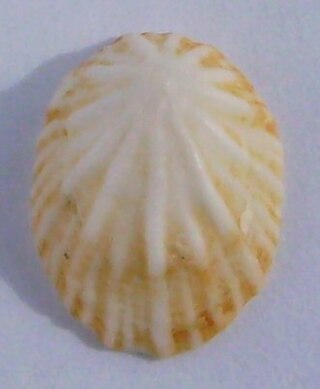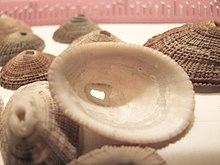
Scutus is a genus of large sea snails or limpets with the common name "shield shells". These are marine gastropod molluscs in the family Fissurellidae, the keyhole limpets and slit limpets.

Diodora is a genus of small to medium-sized keyhole limpet in the family Fissurellidae.

Hemitoma is a genus of slit limpets, marine gastropod molluscs in the family Fissurellidae, the keyhole limpets and slit limpets.

Scutus unguis, common name the northern duck's bill, is a species of large sea snail or limpet, a marine gastropod mollusk in the family Fissurellidae, the keyhole limpets and slit limpets.

Fissurellidea is a genus of sea snails, marine gastropod mollusks in the subfamily Diodorinae of the family Fissurellidae, the keyhole limpets.

Zeidora is a genus of sea snails, marine gastropod mollusks in the family Fissurellidae, the keyhole limpets.

Dendrofissurella is a monotypic genus of minute deepwater keyhole limpets, marine gastropod mollusks in the family Fissurellidae, the keyhole limpets and slit limpets.

The subfamily Emarginulinae, common name keyhole limpets and slit limpets, is a taxonomic subfamily of limpet-like sea snails, marine gastropod molluscs in the family Fissurellidae, the keyhole limpets and slit limpets.

The subfamily Fissurellinae, common name the keyhole limpets and slit limpets, is a taxonomic subfamily of limpet-like sea snails, marine gastropod molluscs in the family Fissurellidae.

Montfortia is a genus of sea snails, marine gastropod mollusks in the family Fissurellidae, the keyhole limpets and slit limpets.

Montfortista is a genus of sea snails, marine gastropod mollusks in the family Fissurellidae, the keyhole limpets and slit limpets.
Montfortulana is a genus of sea snails, marine gastropod mollusks in the family Fissurellidae, the keyhole limpets and slit limpets.

Puncturella pelex is a species of sea snail, a marine gastropod mollusk in the family Fissurellidae, the keyhole limpets and slit limpets.
Puncturella fastigiata is a species of sea snail, a marine gastropod mollusk in the family Fissurellidae, the keyhole limpets and slit limpets.
Zeidora calceolina is a species of sea snail, a marine gastropod mollusk in the family Fissurellidae, the keyhole limpets and slit limpets.

Zeidora nesta is a species of sea snail, a marine gastropod mollusk in the family Fissurellidae, the keyhole limpets and slit limpets.

Zeidora reticulata is a species of sea snail, a marine gastropod mollusk in the family Fissurellidae, the keyhole limpets and slit limpets.
Emarginella is a genus of small keyhole limpets, marine gastropod molluscs in the family Fissurellidae.

The Zeidorinae, common name keyhole limpets and slit limpets, is a taxonomic subfamily of limpet-like sea snails, marine gastropod molluscs in the family Fissurellidae, the keyhole limpets and slit limpets.

The Diodorinae, common name keyhole limpets and slit limpets, is a taxonomic subfamily of limpet-like sea snails, marine gastropod molluscs in the family Fissurellidae, the keyhole limpets and slit limpets.

















